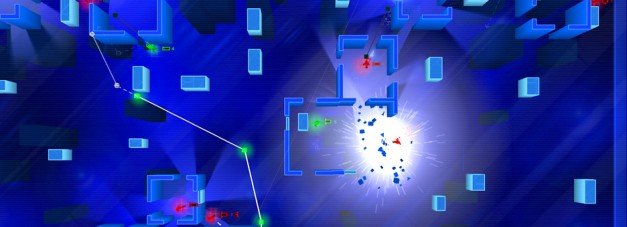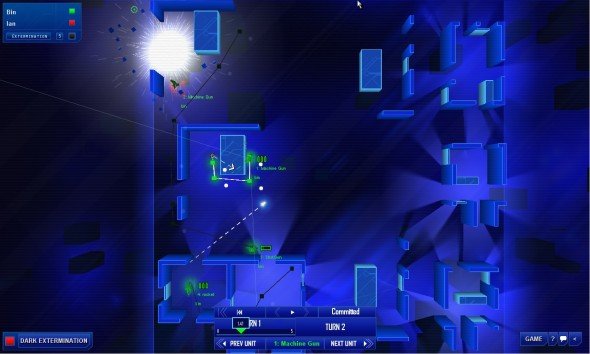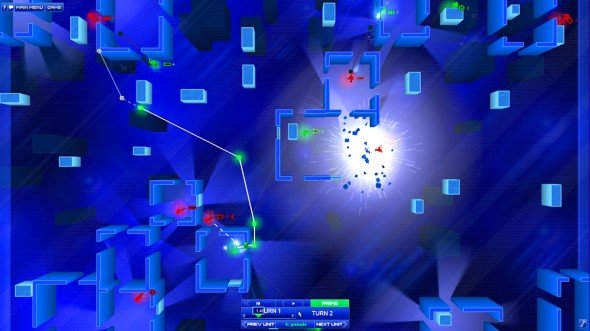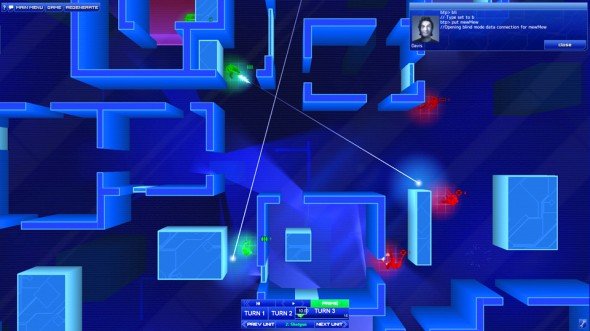Frozen Synapse preview

I've drawn a Venn diagram to represent my FPS and strategy gaming experience. In the left ring: my [Evan pauses, spit-polishing his war monocle] years of league play in Team Fortress Classic and Tribes; 400 hours of ArmA 2. In the right circle: a shameful Bronze league StarCraft II ranking and a trail of unfinished save files for Total War and X-COM.
Frozen Synapse cares about both of these zones; it's a miracle middle-ground for those of us that seem to lose our intuition when transitioning from an FPS to a turn-based game. Frozen Synapse relies as much on my instincts about positioning and timing as it does my (limited) strategic wit.

I'm instantly wooed as I score my first kill with explosives. I order my grenadier, who's at the bottom hallway of a T-shaped intersection, to bounce a 'nade off a wall straight ahead. I do this by carefully drawing a trajectory for the shot—like you might click-drag a line in Photoshop. As the next turn plays out, my grenade bounces down the hall to the left and splatters the enemy around the corner. It's such a familiar feeling—it's the same empowering buzz of luck, timing and intuition that I get in Counter-Strike when I plink a hand grenade blindly down a hallway in cs_office and net a kill.
Like CS, Synapse is a game of angles and anticipation. There's no economy, equipment menu, experience points or fog of war to worry about—just a pile of men with guns stuffed inside a maze of walls for you to fling death at. You're a tactician, controlling a handful of machinegunners, shotgunners, rocketmen and snipers in a top-down, abstracted floorplan. You plan out a turn by creating a movement path (click-dragging waypoints) and aim orders (telling a unit to point their weapon in a specific direction to spot an enemy). Then, you hit a button that executes both you and your enemy's orders simultaneously and see what happens.
“Simultaneous turn-based strategy” is the name for it; imagine a chess game where—instead of alternating turns—you can move any and all of your pawns, rooks and other pieces in any single turn but your opponent can do the same.

Synapse takes that system a step further by simplifying units down to barebones abstractions of soldiers. Your units are soulless clones—a rocketman is essentially an RPG with a body attached to it. And while I love nurturing a set of soldiers over time with experience points or equipment in games like X-COM and Jagged Alliance, Synapse's rock-paper-scissors simplicity is satisfyingly mathematical. When your machinegunner opens up on an enemy, the only factors in play are range, vision and cover.
In one mission, I have to escort three AI-controlled scientists from the left side of the map to the right side, covering their escape. After two attempts, I finally grind out a win by patiently programming my units. I turtle my shotgunner in a corner and give him only a narrow angle to look through—a windowsill where he'll have a clear shot at any passers-by. He buckshots two enemies in the spine. I tell my machinegunner to watch north for half of his turn, then backpedal south while aiming to the west, and he tags two more enemies before being lobotomized by a sniper.
Keep up to date with the most important stories and the best deals, as picked by the PC Gamer team.
The storytelling that binds this less-is-more strategy together is actually very complex. Synapse is set in a near-future where a new sort of augmented reality network called “The Shape” is widely used—like a reborn internet—as a form of communication and business. This is where it gets a little Matrixy. “Humans are able to use The Shape for their own purposes, but it's also home to unique incorporeal lifeforms, known as 'shapeforms,'” Mode 7's writer, audio and marketing man Paul Taylor explains.
“The player encounters several factions throughout the city, all of whom are opposed to the corporate group controlling The Shape, but have their own differing ideologies.” One of these groups is The Blue Sunlight Foundation, “a religious organization whose creed states that the city is a key component in the 'Omega Point,' an end-of-the-world scenario in which all matter contracts to a single point with infinite mass,” Taylor says. They probably throw a hell of an ice cream social.
In the missions I played, Mode 7 showed incredible restraint in limiting this complex exposition to fast, introductory chatter between characters that act as your operators during each mission. But as such, I never got a mental foothold on exactly what The Shape was, who I was fighting or what elaborate conspiracy I was trying to foil. Admittedly, most of the plot will be housed at the between-mission map, which I saw less of.
I do wish that Synapse's barebones visuals could carry more of the burden of its story. As an art style, it's almost contextless, which certainly helps it clearly represent the movement and combat orders you issue to troops, but it doesn't convey any flavor of the world you're playing in.

If Ghost in the Shell-style corporate conspiracies are your thing, you'll eat the story up, but Synapse is driven by its gameplay more than its plot. The map layouts in single-player are randomized, meaning you can't beat any mission with a single "puzzle" solution, which I love.
There's also a foolproof random scenario generator that cranks out limitless skirmishes against the AI and fully-featured online multiplayer. Synapse's rules, readability and unintimidating depth make it a refreshing strategy entry; the Counter-Strike player in me loves that every mission is about the same length of a multiplayer FPS match—between four and 10 minutes.
Frozen Synapse is available for pre-order here . Pre-orders also receive a free, second copy of the game for a friend.

Evan's a hardcore FPS enthusiast who joined PC Gamer in 2008. After an era spent publishing reviews, news, and cover features, he now oversees editorial operations for PC Gamer worldwide, including setting policy, training, and editing stories written by the wider team. His most-played FPSes are CS:GO, Team Fortress 2, Team Fortress Classic, Rainbow Six Siege, and Arma 2. His first multiplayer FPS was Quake 2, played on serial LAN in his uncle's basement, the ideal conditions for instilling a lifelong fondness for fragging. Evan also leads production of the PC Gaming Show, the annual E3 showcase event dedicated to PC gaming.

